Technique
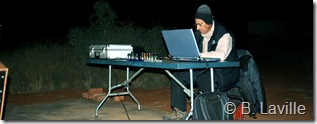 |
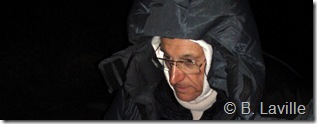 |
The technique I use for my observations has improved over the years and now fully compensates my inability to draw straight from the telescope ocular. The aim I pursue is to sketch, or at least attempt to do so. I want to draw everything that I see, but only what I can see. I do not seek to interpret, modify, add, or improve on real life. A sketch, which reminds me of the detail of what I saw is an achievement for me, anything else fails to satisfy me and sends me back to the drawing board!
1. Preliminary studies
I start the day going over the plans I have for the night. I read all the information I can get and observe the detail all the available pictures and sometimes redefine my goals, noting for example which region HII, which central star, which weaker star on the edge of the halo I need to focus on etc. I try to find out as much as possible before I start any observations.
I file my targets by order of observation in function of their transit and their height on the horizon during the night to avoid zenith angles, which are difficult to access with a Dobson.
2. The rough draft
Experience shows that I need to spend between one and two hours per target on a T635 to observe, sketch it and take down notes as I’m rather prolific: I need two or three pages per object, sometimes even more! However, I don’t make drawings, but drafts, actually map-like designs. I outline the isophotes, i.e the light zones, exactly as a cartographer would emphasize relief contour lines. I also add more precise details according to the scales developed by the publication Extreme Sky (see publications) and use abbreviations (see thumbnail), according to the diameter of the instrument used, there will be more, or less information, as in M17 with the 70 shutter and M77 with the 635 Dobson.
.
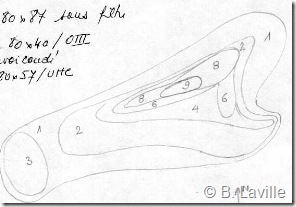 |
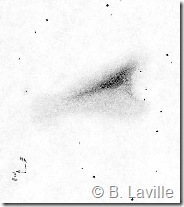 |
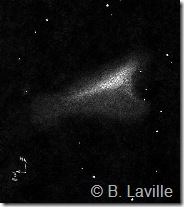 |
Consequently, 5 sketches a night is a good harvest for me!
All my drafts and notes are saved in 200 page notebooks, rather than in folders. It may appear odd to some, but I feel it’s easier to work and have safe backups that way, in February 2009, at the time of writing, I’m on my 18th notebook!
3. The sketch
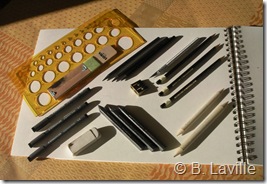 Once I have my notes and drafts, I can proceed to the next step: the sketch. I take my time and sometimes end up finalizing my work several days or weeks after the rough draft, this means that I don’t need to depend on my memory and my mind is free to concentrate upon the work at hand. For example, when I come back from a fortnight in Namibia and notebooks full of notes, I need a good month to process all the information I’ve collected. I draw on white paper, 200 gr/sqm, 21 x 29.7 cm using the following tools:
Once I have my notes and drafts, I can proceed to the next step: the sketch. I take my time and sometimes end up finalizing my work several days or weeks after the rough draft, this means that I don’t need to depend on my memory and my mind is free to concentrate upon the work at hand. For example, when I come back from a fortnight in Namibia and notebooks full of notes, I need a good month to process all the information I’ve collected. I draw on white paper, 200 gr/sqm, 21 x 29.7 cm using the following tools:
Charcoal pencil 2H, 6H, et 9H, pencil crayon HB, 2H, et 4H, shading pencil made out of blotting paper, eraser and pencil eraser, lining pens with Indian ink, pencil sharpener, razor blade, scissors, ruler, and finally a lettering stencil with graduated circles
 The clouds are darkened with the shading pencil. I start using a 9H charcoal pencil to make a mark, as dark as possible, on a sheet of foolscap, then I rub it with the shader and use the blackened shader on the drawing paper. This way I don’t have any visible pencil strokes or dark patches: I try to keep the result shaded, as in real life observation.
The clouds are darkened with the shading pencil. I start using a 9H charcoal pencil to make a mark, as dark as possible, on a sheet of foolscap, then I rub it with the shader and use the blackened shader on the drawing paper. This way I don’t have any visible pencil strokes or dark patches: I try to keep the result shaded, as in real life observation.
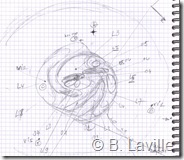 |
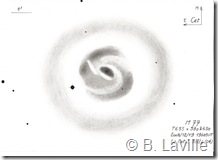 |
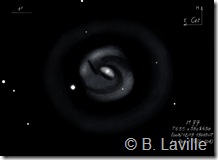 |
As for large areas of weak nebulosity, I use my fingertips instead of the shader to design the external spires in M 77 for example.
For limited and very contrasted areas of nebulosity, I use 2H and 6H charcoal, sometimes 9H for face views of stellar nucleus of a very bright galaxy; for extremely small details I use 2H and 4H pencils.
Indian ink and liners are used for stars and, with the help of a stencil, the shape and diametre of the stars is easy to reproduce. I find it most effective if the stars increase of 0.5mm for each degree of magnitude. Very shiny stars, m < 5 for the L80, or m < 11 for the T635, need a cross-shaped emphasis to reproduce the double-crested spokes of the secondary spider whose length is proportionate to the brightness of the star.
Almost all of my pictures are oriented to the north and I add their scale as well as the constellation. The title of the sketch gives the name of the object, from several catalogues when necessary, the observation tool, the enlargement, filters if used, the date and universal time as well as the site from which the observation was made.
4. Handling pictures
Now the picture needs to be scanned and converted to a negative with light clouds and white stars on a black background. The pictures aren’t really changed, they are just enhanced in terms of light and colour in certain areas using the Paint Shop Pro histogramme or changing the lighting using the soft focus to emphasize the magnifying influence. I also attempt to reproduce the glare of very shiny stars with the halo function.










































